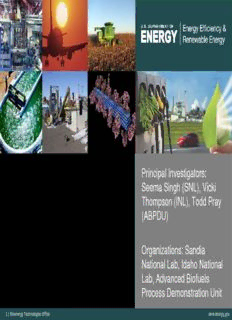Table Of ContentPrincipal Investigators:
2015 DOE BioEnergy Technologies Office
Seema Singh (SNL), Vicki
(BETO) Project Peer Review
Thompson (INL), Todd Pray
Date: March 23th, 2015
(ABPDU)
Technology Review Area: Feedstock-
Conversion Interface
Determining the Impact of MSW as a Organizations: Sandia
Feedstock Blending Agent (WBS 2.2.1.103- National Lab, Idaho National
105)
Lab, Advanced Biofuels
Process Demonstration Unit
1 | Bioenergy Technologies Office eere.energy.gov
Goal Statement
• Goal and outcome: Identify the optimal blend of municipal solid waste
(MSW) to serve as feedstocks for the production of fermentable sugars
using an ionic liquid-acidolysis process.
• Relevance to BETO: MSW is a promising but nascent feedstock, and the
blending of MSW with different types of feedstocks to decrease costs and
maximize availability is quickly gaining prominence. Few studies have
been carried out to determine the impact of these blended feedstocks on
the overall process efficiency of a wide range of platform technologies.
This project will:
– identify MSW blends that meet feedstock cost targets
– achieve high yields of fermentable sugars through the use of ionic liquids and
acidolysis
– technology will be demonstrated at the 100L scale at the ABPDU at the end of
FY15
2 | Bioenergy Technologies Office
Quad Chart Overview
Timeline Barriers Addressed
• Start date: October 1, 2013 • Ft-A Feedstock availability and
cost
• End date: September 30, 2015
• Bt-D Pretreatment processing
• Percent complete: 75%
• Bt-J Catalyst development
Budget
Partners
Total Costs FY Total Planned
• Partners
14–FY 15 Funding (FY 14-
Project End Date
Idaho National Laboratories –
o
Vicki Thompson
DOE Funded $235,600 $500,000 Lawrence Berkeley National
o
Laboratory – Todd Pray
3 | Bioenergy Technologies Office
Project Overview
• Project history
– Project initiated in FY14 as a “seed” AOP between SNL, INL, and LBNL-
ABPDU
– Achieved major milestone in FY14 using MSW paper fraction
– Complementary to other BETO-funded feedstock-conversion interface
AOPs (WBS 1.2.2.1)
• Project context
– MSW blends could provide low-cost, nationally available feedstocks suitable
for conversion
– Acidolysis using ionic liquids avoids the use of enzymes
• High-level objective
– To conduct a comparative pretreatment and hydrolysate study to
understand and track the impact of MSW as a blending agent with
herbaceous (e.g., switchgrass) and agricultural residues (e.g., corn stover)
as a function of pretreatment and hydrolysis.
44 || BBiiooeenneerrggyy TTeecchhnnoollooggiieess OOffffiiccee
Technical Approach
Substrate: MSW blends produced and distributed by INL
• Approach
- Screen combinations of blends and conversion chemistries at the bench scale
- Identify parameters for optimal sugar yields
- Scale-up SNL bench results at the ABPDU
• Primary challenges:
- Effective process controls to identify key optimization parameters
- Degradation of MSW blends over time
- Identifying suitable MSW blends that meet cost and performance targets
- Scaling up process
• Success factors:
- Achieving high yields of sugars from MSW blends
- Maintain high yields as a function of scale
- Minimal production of known fermentation inhibitors during process
55 || BBiiooeenneerrggyy TTeecchhnnoollooggiieess OOffffiiccee
Management Approach
Management Approach:
Critical Success Factors:
•Employ expertise in feedstocks (INL), •Use quarterly milestones to track
conversion chemistries (SNL), and progress and down-select options
process scale-up and controls
(ABPDU)
•Focus on rapid screening and
scale-up
•Leverage experience from two
biomass conversion centers
•Phone calls every 3 weeks, site
visits once per FY
•Work with MSW cost tool to identify
optimal blends that are “real world”
•Contributions from all partners in
managing the project and tracking
•Leverage input and collaborations
progress
from other BETO-funded projects
feedstock-conversion interface
•Divide research in a manner that
leverages each partners strengths
66 || BBiiooeenneerrggyy TTeecchhnnoollooggiieess OOffffiiccee
Feedstock Target (INL Biomass Program)
2017 Program Goals Current State of Technology
• Biomass cost $80/ton • Biomass cost $141.70/ton (corn
– Feedstock costs stover)
– Harvest and collection • Feedstock costs $40
• Harvest and collection $22.20
– Transportation
• Transportation $11.50
– Preprocessing
• Preprocessing $43.60
– Storage
• Dockage for not meeting specs $20.10
• Sugar content >59% • Storage $4.30
• Moisture content <20%
• Ash content
– Biochem <5%
– Thermochem <1%
77 || BBiiooeenneerrggyy TTeecchhnnoollooggiieess OOffffiiccee
Is MSW a Solution?
• Advantages
– Low cost
– Collection infrastructure
– Under-utilized
– Distributed generation
– Renewable
• Disadvantages
– Highly variable
• Season
• Year
• Region
• “coyote effect”
– Low quality
• Sorting
• Upgrading
Source:
88 || BBiiooeenneerrggyy TTeecchhnnoollooggiieess OOffffiiccee
http://www.epa.gov/epawaste/nonhaz/municipal/index.htm
Driving Towards $80/ton
Feedstocks with MSW Blends
Delivered Feedstock Costs
CS:MSW = 4:1
Corn Stover
70$/ ton 80$/ ton >100$/ ton
DOE target
CS:MSW = 1:1
99 || BBiiooeenneerrggyy TTeecchhnnoollooggiieess OOffffiiccee
Feedstock Processing using Ionic Liquid
Room Temperature, Molten Salts
Cation determines:
- stability
- properties
Anion determines:
- chemistry
- functionality
1100 || BBiiooeenneerrggyy TTeecchhnnoollooggiieess OOffffiiccee
Description:Lab, Advanced Biofuels. Process Feedstock Target (INL Biomass Program) . Chenlin Li, Deepti Tanjore, Akash Narani, Todd R. Pray, Blake A. Simmons, Seema. Singh, Blending Municipal Solid Waste with Corn Stover for Sugar

